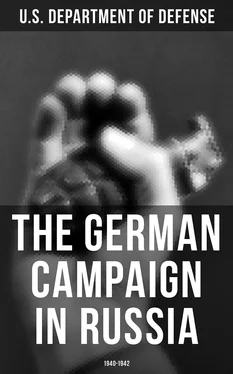(2) The industrial production would depend on the immediate availability of electric power plants and the delivery of raw materials generally unavailable in European Russia.
c. Until the establishment of a link with the Far East, Germany would be short of such strategic materials as rubber, tungsten, copper, platinum, zinc, asbestos, and jute.
d. The area south of the Volga and Don estuaries including the Caucasus would have to be included among the objectives of the operation. The oil produced in the Caucasus region would be essential for the exploitation of any territories occupied in Russia.
e. By occupying European Russia, Germany would seize 75 percent of the total Soviet armament potential and almost 100 percent of the precision-tool and optical industries.
The study was submitted to Hitler who, though recognizing its intrinsic value, failed to make any basic changes in his overall military-political plans.
Directive BARBAROSSA
(18 December 1940)
Table of Contents
On 6 December General Jodl requested General Warlimont to draw up a directive for the campaign against Russia on the basis of the preliminary plan that had been approved by Hitler. Six days later the draft of Directive No. 21 was submitted to Jodl who made a few insignificant changes and ordered a revised draft prepared. The same day the Navy submitted a report stressing the danger of starting a war on a second front while Germany's naval forces were fully engaged in the struggle against Britain. On 16 December Warlimont submitted the revised draft of the directive to Jodl who was to present it to Hitler the next day. During their conference Jodl and Warlimont discussed the dangers of a two-front war and the serious POL problems it would involve.
On 17 December Jodl presented the draft of Directive No. 21 to Hitler who made some basic changes with regard to the mission of the two army groups that were to be committed north of the Pripyat Marshes. First priority was to be given to the capture of Leningrad and Kronshtadt and to the destruction of the enemy forces in the Baltic States. The advance on Moscow would not be resumed until these objectives had been attained. Only if Russia's military machine collapsed earlier than anticipated would Army Group Center be permitted to drive simultaneously on Leningrad and Moscow.
After the necessary changes had been incorporated in the directive it was signed by Hitler on 18 December and distributed to the services under the new cover name Operation BARBAROSSA. The directive read as follows:
Directive No. 21
Operation BARBAROSSA
18 December 1940
The German Armed Forces must make preparations to crush Soviet Russia in a lightning campaign, even before the termination of hostilities with Great Britain (Operation BARBAROSSA).
For this purpose the Army will commit all available forces except those needed to safeguard the occupied territories against surprise attacks.
The Air Force will earmark sufficient forces in support of the ground operations to guarantee the rapid conclusion of this campaign and to minimize any potential damage eastern Germany might suffer through enemy air attacks. The concentration of air power in the East is, however, subject to certain limitations. First, all German-held military bases and war production centers must be adequately protected against enemy air raids. Second, the air offensive against Great Britain and against its life lines in particular must not be slowed down.
The Navy will continue to focus its attention on Great Britain while the campaign against Russia takes place.
In due time, i. e., at least eight weeks before the intended start of the operation, I shall issue a directive for the strategic concentration against Soviet Russia.
Any preparations which require more time and are not already under way will be initiated immediately and brought to a conclusion before 15 May 1941.
It is absolutely essential that the preparations for the attack remain unobserved.
The operational planning of the individual services should be based on the following premises:
I. Overall Plan
During the initial phase the bulk of the Russian Army stationed in western Russia is to be destroyed in a series of daring operations spearheaded by armored thrusts. The organized withdrawal of intact units into the vastness of interior Russia must be prevented.
During the next phase a fast pursuit will be launched up to a line from which the Russian air force will be incapable of attacking German territory. The ultimate objective of the operation is to screen European against Asiatic Russia along the course of the Volga and thence along a general line extending northward toward Archangel. Thus, if necessary, the German Air Force would be in a position to neutralize the last industrial region remaining in Russian hands, i. e. that situated in the Urals.
As a result of these ground operations the Russian Baltic Fleet will rapidly lose its bases and thus cease to be operational.
Any effective interference by the Russian Air Force will be eliminated by the delivery of decisive blows at the very beginning of the campaign.
II. Prospective Allies and their Mission
Romania's and Finland's active participation in the war against Soviet Russia is to be anticipated; they will provide contingents on either wing of our ground forces.
In due course the Armed Forces High Command will approach these two countries and make arrangements as to the manner in which their military contingents will be placed under German command at the time of their intervention.
Romania will employ elite forces to give at least initial support to the offensive launched by the German southern attack forces. In addition, Romania's mission will call for tying down enemy forces in the south, wherever no German units are committed, and lending assistance in maintaining the lines of communications.
Finland will cover the concentration of the German Force North (elements of Force XXI) which will be transferred from Norway, and the Finnish troops will operate in conjunction with this force. Moreover, Finland will have to neutralize Hanko.
It may be assumed that, by the start of the campaign at the latest, there will be a possibility of using the Swedish railroads and highways for the transfer of the German Force North.
III. The Campaign Plans
A. Army (in conformity with the plans submitted to me by the Army) : For the purpose of the campaign the theater of operations is divided into a southern and northern part by the Pripyat Marshes. The main effort is to be placed north of the Pripyat, where two army groups are to be committed.
Of these two army groups the one on the right will be provided with especially powerful motorized infantry and armored forces. Its mission will be to thrust from the area around, but especially north, of Warsaw and to shatter the enemy forces in White Russia. This preliminary operation will set the stage for a pivoting movement performed by strong motorized elements that will drive northward in order to annihilate the enemy forces in the Baltic area in conjunction with the northern army group which will be driving from East Prussia in the general direction of Leningrad. After this most urgent mission has been successfully accomplished, the cities of Leningrad and Kronshtadt must be captured. Only then will the offensive operations leading to the seizure of Moscow, the important communications and armament production center, be continued. Simultaneous drives toward both objectives might be envisaged only in the event of an unexpectedly rapid collapse of the Russian resistance.
Читать дальше












